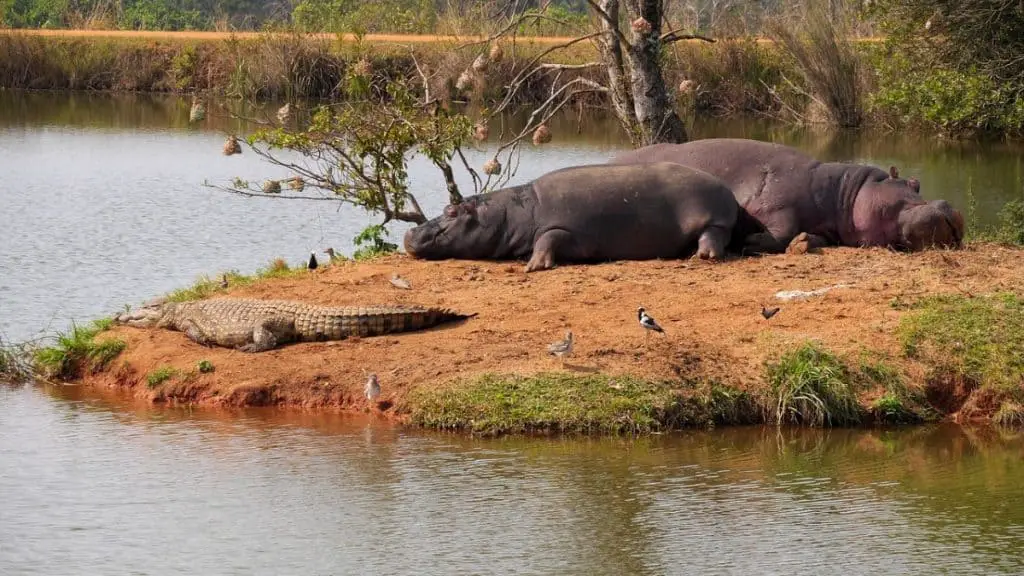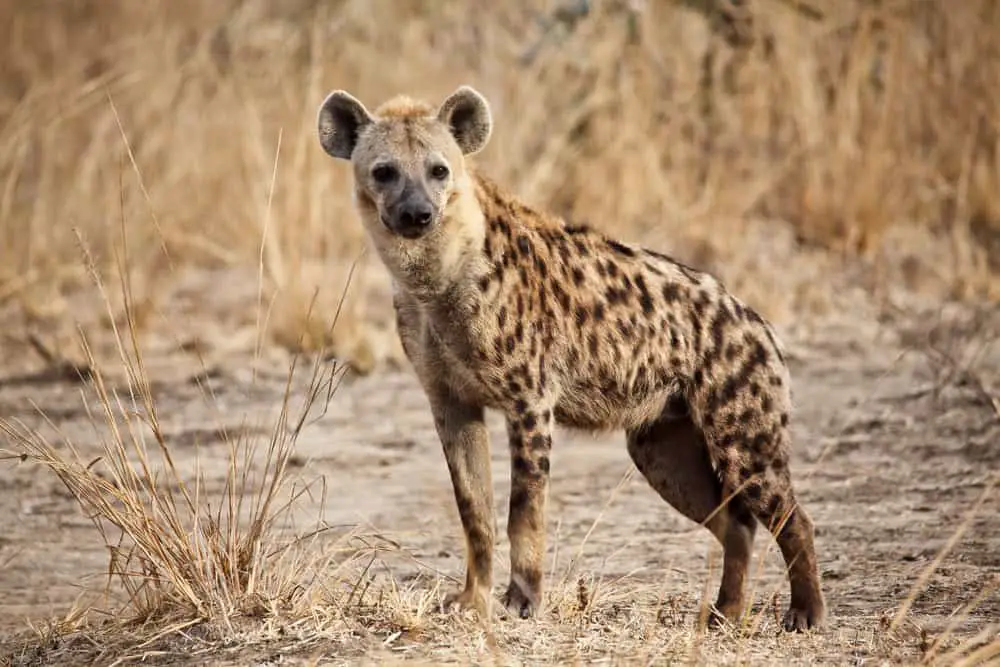Hippopotamuses, commonly referred to as hippos, are large mammals that inhabit rivers and lakes in sub-Saharan Africa. These animals have few natural predators due to their immense size and strength.
It’s important to note that adult hippos are generally considered apex predators in their ecosystems and are not commonly preyed upon.
Hippopotamuses typically weigh between 1,500 and 4,300 kilograms; they possess a formidable set of sharp teeth with which they can defend themselves against potential attackers. Despite this defensive capability however, some species do pose a significant threat to the lives of these gentle giants.
In particular, crocodiles have been known to attack adult hippos when provoked or threatened. Other predators include African lions and spotted hyenas who mainly target young calves or injured adults unable to fight back effectively.
Hippos, particularly adult ones, do not have many natural predators due to their large size, aggressive behavior, and powerful jaws. However, there are a few potential predators that can pose a threat to hippos, especially young or injured individuals.
| Predator | Description |
|---|---|
| Lions | Lions have been known to prey on young or injured hippos, especially near water sources. |
| Crocodiles | Large Nile crocodiles can pose a threat to hippos, especially when they are in the water. |
| Hyenas | Spotted hyenas have been observed scavenging on deceased hippos or targeting young ones. |
| Humans | Humans can be a threat to hippos through hunting, habitat destruction, or conflicts in areas of human-wildlife interaction. |
Overview Of Hippos
Hippos are an iconic species that has roamed the African continent for centuries. They are a keystone species, providing both stability and balance to their ecosystems – a role humans often struggle to live up to as predators in nature.
When it comes to what eats hippos, the answer is multi-faceted. Large apex predators such as lions and crocodiles have been known to hunt adult hippos on occasion. However, these attacks occur rarely due to the formidable size of hippos and because they are typically found in water or mud where their massive weight works against them when trying to flee from danger. Young calves can be particularly vulnerable if left alone for extended periods of time.
Humans also pose a threat by hunting hippopotamus for food or sport although this type of activity is decreasing due to conservation efforts across Africa. As human populations continue to grow near areas inhabited by hippos, habitat loss and fragmentation can further threaten wild populations as well as increased poaching activities leading to more direct mortality rates among adults and young alike.
How Big Are Hippos: Unveiling the Size of Aquatic Mammals
The Natural Predators Of Hippos
Hippos are large, herbivorous animals that inhabit rivers and lakes in Africa. Despite their size, they have several natural predators. These include lions, crocodiles, hyenas, and humans.
The eating habits of hippos can make them vulnerable to predation by these species. Hippos graze on short grasses at night when they come out of the water to feed. This behavior can often place them within reach of predators that would not normally pursue such a large animal.
Lions are known to hunt hippos and will even drag them into deeper waters where they may drown if they cannot escape. Crocodiles also pose a threat as they wait for an opportunity to snatch up an unsuspecting hippo calf or adult from shallow waters. Hyenas take advantage of carcasses left behind after unsuccessful predation attempts by other animals or scavenge meat from kills made by humans hunting hippos for food or ivory tusks.
As one of the most dangerous mammals in Africa, hippopotami must be constantly vigilant against potential threats from both land-based and aquatic predators who seek to capitalize on its distinct behaviors and habitats.
Unveiling the Marvels of Hippopotamus: Nature’s Mighty River Guardians

Crocodiles
The crocodile is a natural predator of the hippopotamus. This apex predator has been documented hunting young and small adults in some areas, but usually only takes carrion when larger adults are available.
Crocodiles are opportunistic feeders that typically hunt alone or in pairs. They mainly target fish and reptiles, although they will also prey on large mammals such as antelope and wildebeest if given the opportunity. Hippos may thus be targeted by these powerful predators at times, particularly when other food sources are scarce.
When selecting a habitat for breeding, adult crocodiles prefer shallow rivers with plenty of vegetation to hide from potential predators while incubating their eggs. Additionally, they need access to deep water where they can find refuge during dry periods or escape danger quickly.
The presence of hippos does not necessarily deter them from inhabiting an area because the two species rarely interact directly; however, their activities might alter the aquatic environment enough to make it unsuitable for crocodiles’ needs.
Hippo Behavior: Exploring the Fascinating Aquatic Behaviors
African Lions
The African savannah is home to a variety of animals, from the mighty hippo to its natural predators – crocodiles and lions.
Another type of large mammal native to the area are giraffes, whose long necks make them an unusual sight. Giraffes are herbivores, meaning they do not hunt other animals for food but instead feed off foliage high up in trees. They have good eyesight and can spot cheetahs when they come too close.
Cheetahs, on the other hand, are carnivorous hunters that rely heavily upon speed to catch their prey. Built for speed with their long legs and powerful muscles, cheetahs can reach speeds of up to 70 miles per hour as they chase down antelopes or gazelles across the plains. While cheetahs usually shy away from humans, if hungry enough they may attack livestock such as sheep or goats and even smaller children if given the opportunity.
Though it’s rare for any animal – including predators – to try taking on a healthy adult hippo due to their size and strength, there have been cases where small groups of lions will attempt a coordinated attack against one.
The outcome often varies depending on individual circumstances; sometimes these attacks end successfully while at other times the lion pride ends up fleeing in defeat after being chased by the angry hippopotamus.
Hippo Behavior: Unveiling the Intriguing Habits
Spotted Hyenas
Spotted Hyenas, also known as Crocuta crocuta are large carnivorous mammals native to the grasslands and savannas of Africa. They are members of the Hyaenidae family along with striped hyenas, brown hyenas, aardwolves, and others.
Spotted hyenas have powerful jaws and sharp teeth that enable them to hunt larger prey such as zebras and wildebeests. Their social behavior is highly organized; they live in clans consisting of up to 80 individuals which cooperate on hunting efforts.
Spotted hyenas have been recorded preying on a wide variety of animals including antelope, gazelles, birds, fish, reptiles, insects and even scavenging from other predators’ kills. Hippos represent an important food source for spotted hyenas in some areas; calves are particularly vulnerable to predation by these strong predators who work in packs.
In addition to killing hippos themselves, spotted hyenas will take advantage of opportunities presented by other predators such as lions who have already killed their own prey near waterholes or rivers where hippos feed and rest during the day.
In terms of dietary habits spottted hyena’s diet mainly consists mostly of carcasses left behind by other predators but they can be opportunistic when it comes to finding meals. As apex predators they play an essential role in maintaining natural balance within ecosystems by controlling populations of wild ungulates like buffalo and antelopes while taking advantage of those same sources for sustenance at times.
By doing this they help prevent over-population amongst smaller herbivores which could lead to vegetation depletion if left unchecked.
Hippo Lifecycle: From Birth to Dominant Hippopotamus

Other Predators
Hippos, the world’s largest terrestrial mammal, are not just prey for humans. While human hunters have long targeted hippos for their meat and ivory tusks, other predators also compete with humans in hunting this powerful animal.
First, Nile crocodiles pose a significant threat to young hippopotamuses by ambushing them while they drink at riverbanks or feed on vegetation near the water’s edge.
Smaller animals like hyenas can scavenge off of carcasses left behind from larger predators; however, during times when food is scarce, these opportunistic carnivores will take down small juvenile hippos as well.
Lions may even hunt adult hippos if they come across them alone and vulnerable.
The African fish eagle is another predator that feeds upon hippo calves by snatching them away from the herd using its talons to carry them into trees for consumption.
Other birds such as herons target eggs laid in shallow waters along lakes and rivers where female hippos nurse their young ones.
In addition to natural predators, humans continue to be one of the main contestants eating Hippopotamus meat throughout Africa due to its availability and taste profile.
Unveiling the Secrets of Hippo Behavior: Dive into the World of Hippos
Hippo Adaptations For Survival
The morning sun rises on the horizon, and with it comes a new day of survival for the African hippopotamus. The majestic creature stands in defiance against its many predators, chief among them being humans.
This species has adapted over millions of years to live alongside other animals in Africa’s savannahs and rivers. But as human interference intensifies and climate change alters the landscape, this amazing animal faces an uncertain future.
With their size, intimidating tusks and powerful jaws, hippos are equipped to defend themselves from most common predators such as lions or crocodiles. However they still have enemies that pose more of a challenge: poachers who seek their ivory tusks; farmers whose crops they inadvertently damage; and disease-carrying parasites which can severely weaken them if left untreated.
To combat these threats, hippos rely on camouflage to hide in murky river water during the day and venture out onto land at night when they are less vulnerable to attack. Hippos also have unique adaptations that help protect them from harm. They secrete an oily substance called ‘blood sweat’ which gives them a natural sunscreen protection from the intense rays of the African sun. Their thick skin helps keep them cool by preventing heat loss through evaporation while providing armor against thorns and sharp objects found in dense vegetation where they graze for food.
By using these strategies together, hippos can successfully safeguard themselves in times of danger – but only until now…
Conclusion
Hippos are an incredible and fascinating species. Despite their size, they have a few natural predators that pose a threat to them in the wild.
Crocodiles, African lions, spotted hyenas, and other animals can all prey on hippos if given the opportunity. Fortunately for these creatures, they possess several adaptations that help keep them safe from danger.
What is most remarkable about hippos is how they survive against such fierce opposition. While not completely invulnerable to attack, it’s clear that nature has equipped this animal with the necessary tools for survival-making them truly awe-inspiring creatures of the wild.
Do their capabilities extend past what we see? This question remains unanswered as further studies are needed to fully understand the resourcefulness of the majestic hippo.

